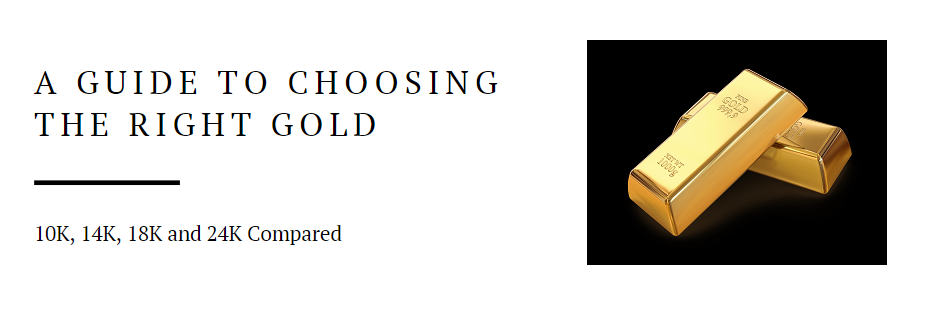
Gold has been the most popular choice for jewelry-making for centuries. In fact, gold jewelry dates back to 4,000 B.C. and has become utterly entwined with our perceptions of luxury and romance. Gold is a beautiful metal that can be a wonderful choice for jewelry, providing you make the right choices.
What is Karat?
Karat is the term used to express the fineness of gold. Gold is often mixed with alloying base metals to make it more durable, thus it is not 100% pure. Gold is measured in 24 parts; this means that 24 karat gold is considered 100% pure gold while 18 karat gold is 18/24 = 75% gold.

While karat is used specifically for gold, other metals use the millesimal fineness system which denotes fineness in parts per thousand. You may notice an 18k gold ring is stamped with the number ‘750’ = 75% gold. Jewelry listings will use karat to express gold fineness but hallmarks often use the millesimal system.
Why isn’t Gold Pure?
Some buyers contact me with concerns about gold purity, wondering whether the lack of purity means the setting is inferior. This is not true. Pure gold is extremely soft – it can be manipulated and broken, even by hand. As diamonds are so hard, using pure gold to set them would not work. The base metals added to gold improve the durability and are therefore more desirable for customers.
Gold purity is viewed differently depending on where you are in the world. Across India and China, 24 karat gold is widely used for jewelry and prized for its purity and intense colour. In the USA, 14 karat gold is a popular choice for fine jewelry, while this fineness is unusual in Europe (where 18 karats is the most popular).
Each purity level has its own pros and cons so there is no right or wrong decision.
10K Gold
In the USA, 10k gold is the lowest purity than can be legally sold as ‘gold’ in the USA (in Europe, 9 karat gold is used for jewelry). It is 10/24 parts gold.
Pros:
- The most affordable gold on the market
- Highly durable and harder to bend or scratch than gold with higher purity
- 10k gold has a pale color which some buyers prefer to the richer gold colors (although this is also negative point for some buyers – a matter of preference)
Cons:
- Copper, silver, iron, nickel and zinc can all be used to strengthen gold and any one of these metals can trigger allergic reactions in some wearers. The lower purity of gold makes this more common in 10k gold jewelry. If you intend to wear the jewelry every day and are susceptible to dermatitis, eczema, metal allergies or simply have sensitive skin, 10k gold would not be a good choice.
- 10k gold is not widely available for fine jewelry
14K Gold
14k gold is the most popular purity for wedding rings and engagement rings across the USA. It strikes a wonderful balance between beauty, durability and affordability.
Pros:
- Affordable
- A wonderful color that isn’t quite as intense yellow/orange as 18k/24k gold
- More durable than 18k gold and harder to scratch
- Widely available across the USA for a variety of setting styles
Cons:
- Less utilised in Europe
- If you are looking for a deep color, 14k may still be too pale
18k Gold
18k gold is extremely popular with high-end jewelers and customers alike.
Pros:
- The highest gold purity for jewelry that is still practical and can be used to set diamonds
- A classic, rich color
- It will make diamonds look whiter
Cons:
- Considerably more expensive
- Prone to scratching
24k Gold
You are unlikely to find 24k (pure gold) being offered for engagement rings and wedding bands in the USA. It is simply too soft and will scuff/bend with relative ease. 24k gold is also polarising due to its intense orange/gold color – whilst some customers love this, others find it too bright. If you want purity and a rich color, my recommendation would be to stick with 18k gold which offers greater durability.
Here is a detailed Gold Karat Summary Chart:
| Karat Gold | Parts Gold | Percentage Gold | Decimal Part Gold |
|---|---|---|---|
| 10 kt | 10 in 24 | 41.67% | 0.4167 |
| 14 kt | 14 in 24 | 58.33% | 0.5833 |
| 18 kt | 18 in 24 | 75% | 0.75 |
| 24 kt | 24 in 25 | 99.99% | 0.9583 |
Will Gold Turn my Finger Green?
A common question amongst buyers is the way in which gold reacts with the skin. The inclusion of base metals can cause reactions with the skin that result in (temporary) green or black discolouration. Sometimes customers purchase a 14k gold ring and later find it is causing discoloration. This is understandably alarming.
Discoloration does not mean the ring is poor quality or that you have been sold a lower gold purity than expected. It is to do with the way individuals react to the metals. Even 18k gold can cause skin reactions. In most cases these are painless, but unsightly.
There are options. If you love yellow gold but are sensitive to base metals, rings can be lined with platinum (which is hypoallergenic) – this retains the external gold appearance but will prevent your skin coming into contact with the gold.
Which Type of Gold Should You Chose?
I would also suggest reading my James Allen, Blue Nile and Whiteflash reviews.

I’m Louis Jacobs, the creator of Diamond Expert, a platform where I share my lifetime’s knowledge of diamonds. Born and raised in Antwerp, Belgium, the world’s diamond hub, my fascination with these precious gems began at a young age. I spent over three decades in the diamond industry, earning the reputation of a trusted advisor among friends and family for diamond purchases, particularly engagement rings. Now retired, I’m dedicated to providing online guidance to make your diamond buying experience informed and successful.

